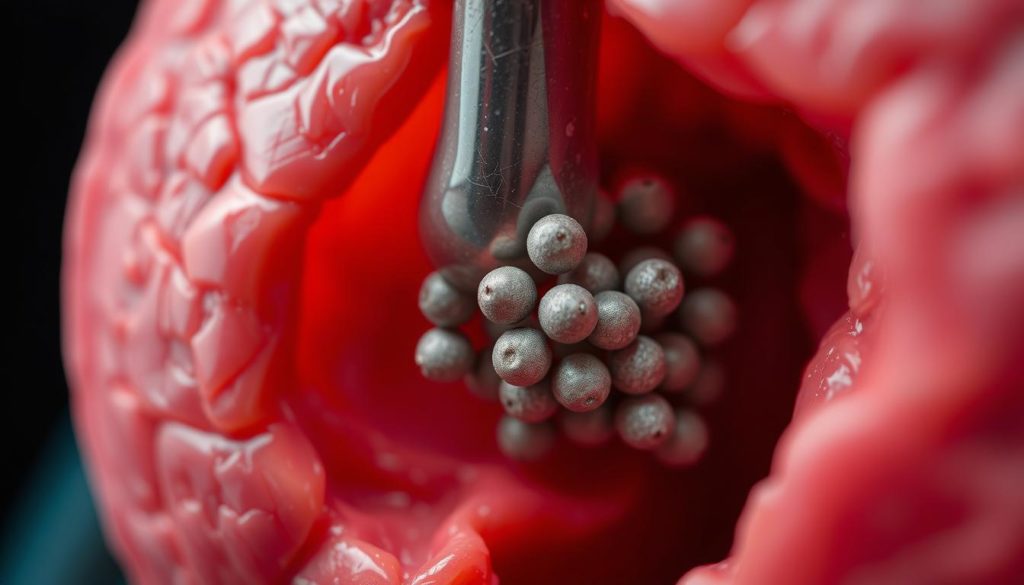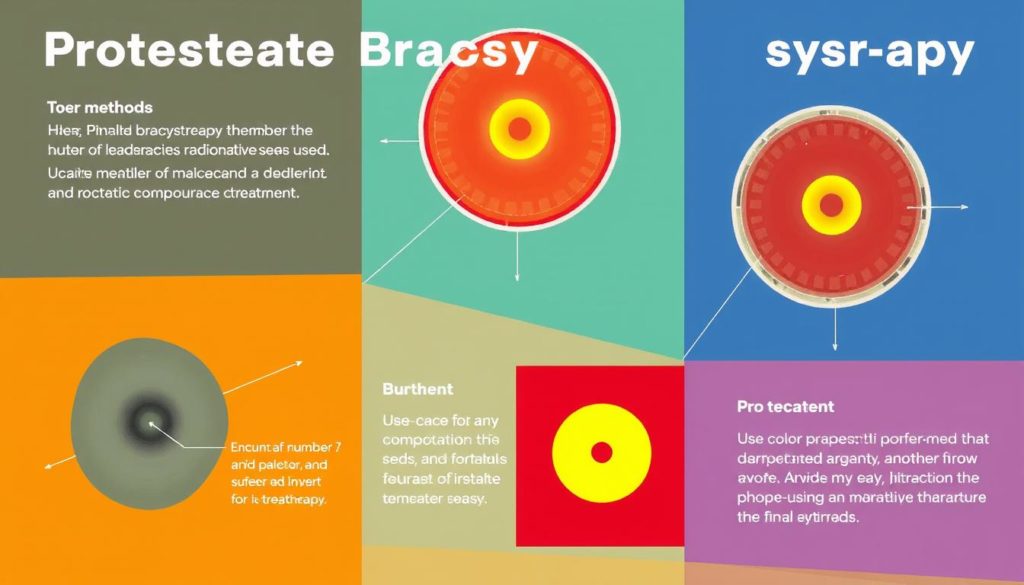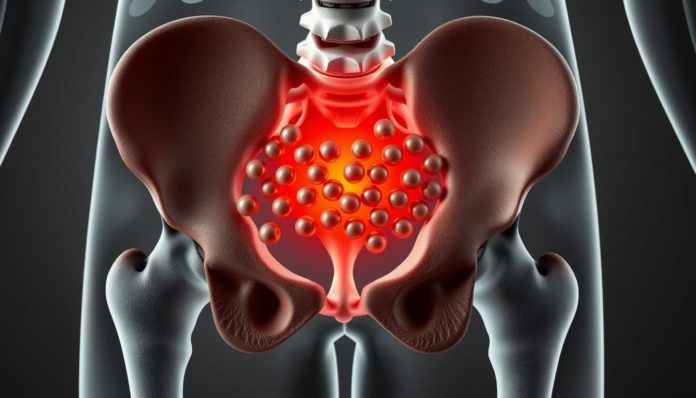In 2018, about 164,690 men in the United States got diagnosed with prostate cancer. It’s the second most common cancer in men. Radioactive seed therapy or brachytherapy is an effective treatment for it.
Brachytherapy uses radioactive seeds placed right in the prostate. This targets the cancer and shields nearby tissues. The process involves materials like iodine-125 or palladium-103. A radiation oncologist and a urologist usually do the procedure. It’s an outpatient service and can match the results of bigger surgeries.
Introduction to Prostate Cancer Radioactive Seed Implants
Radioactive seed implants are key in treating prostate cancer from the inside. This method places tiny radioactive seeds in the prostate gland to fight cancer. It’s less invasive than many other treatments.
The radioactive seed implant procedure works best for early-stage cancers. It can be the main treatment or part of a bigger plan with treatments like external beam radiation therapy (EBRT). This approach helps create tailored treatment plans, boosting patient success.

To start, doctors check if the patient is a good fit for this treatment. If yes, they use ultrasound to implant the radioactive seeds precisely in the prostate. This targets cancer cells while protecting healthy tissue nearby.
Here’s a look at how this method compares with others:
| Treatment Type | Method | Invasiveness | Targeted Effectiveness |
|---|---|---|---|
| Radioactive Seed Implant Procedure | Internal radiation using implanted seeds | Low | High |
| External Beam Radiation Therapy (EBRT) | External radiation directed at the prostate | Moderate | Medium |
| Surgery (Prostatectomy) | Removal of the prostate gland | High | High |
In summary, the radioactive seed implant is a focused, less invasive treatment for prostate cancer. It’s effective for many patients, especially when caught early. These treatments constantly improve, offering better survival rates and life quality for patients.
Types of Prostate Brachytherapy
Prostate brachytherapy tackles prostate cancer with two main methods: Low Dose Rate (LDR) and High Dose Rate (HDR) brachytherapy. Each method helps patients differently, based on their health and needs.

Permanent Seed Implants (Low Dose Rate)
Low dose rate (LDR) brachytherapy places tiny radioactive seeds in the prostate. Over several months, these seeds release radiation straight into the tissue. It’s a good choice for those wanting a simpler treatment with little impact on daily life.
Temporary Seed Implants (High Dose Rate)
High dose rate (HDR) brachytherapy, on the other hand, is brief. It involves inserting radioactive material into the prostate for short times. Treatment is given over several sessions. HDR is flexible, allowing dose adjustments for the best cancer target.
How Radioactive Seed Implants Work
Implanting radioactive seeds in the prostate gland is a big step in treating prostate cancer. It uses the latest tech to hit cancer cells right on target.
Procedure Overview
Doctors put radioactive seeds in the prostate gland, guided by ultrasound. These seeds give off a little bit of radiation. They focus on killing cancer cells but keep healthy cells safe. This method shows the big radioactive seed implant benefits in cutting-edge prostate cancer care.
Types of Radioactive Materials Used
Different radioactive materials are used for these implants. The type used depends on what the patient needs. Here are some common ones:
- Iodine-125: This one lasts longer, giving a steady dose of radiation.
- Palladium-103: Works quicker, good for treatments that need to act fast.
- Iridium-192: Used for strong, fast treatments because it’s really powerful.
- Cesium-137: A flexible option for various treatment needs.
Every patient gets a plan made just for them. This plan looks at the cancer stage, prostate size, and overall health. Personalizing the plan makes prostate cancer care more effective. It brings out the best in radioactive seed implant benefits.
Benefits of Radioactive Seed Implants for Prostate Cancer
Radioactive seed implants mark a big step forward in treating prostate cancer. They target the cancer very precisely. This reduces harm to nearby tissues and organs. By being so exact, the treatment works better and has fewer side effects.
Precision in Treatment
Radioactive seed implants are known for their precise targeting. They are placed right in the prostate gland. This way, the radiation hits the cancer cells hard but leaves healthy tissue alone.
| Treatment Type | Radiation Precision | Impact on Surrounding Tissues |
|---|---|---|
| Radioactive Seed Implants | High | Minimal |
| External Beam Radiation | Moderate | Higher |
| Chemotherapy | Low | Significant |
Limited Damage to Surrounding Tissues
One major plus of this method is less damage to nearby tissues. Older treatments often harm areas around the cancer. But radioactive seed implants focus the radiation mostly on the prostate. This spares healthy cells. It makes life better for patients during and after treatment.
Step-by-Step Radioactive Seed Implant Procedure
The radioactive seed implant procedure begins by making the patient comfortable through general or spinal anesthesia. Next, the patient is positioned strategically for easy access.
An ultrasound probe is then used rectally. This helps with the accurate placement of seeds. It allows real-time viewing during the seed implantation for prostate cancer. Through the skin between the anus and scrotum, the seeds are implanted. They use live ultrasound for precise insertion.
After placing all seeds, doctors check for any stray seeds. These could be in the bladder or urethra. A cystoscope removes them, ensuring no seeds are left behind. Once done, patients can usually go home the same day. This makes the procedure both quick and effective.
- Anesthesia Administration
- Patient Positioning
- Ultrasound Probe Insertion
- Seed Placement Guidance
- Seed Implantation
- Removal of Loose Seeds
- Patient Recovery and Discharge
Prostate Cancer Radioactive Seed Implants
Radioactive seed implants, or brachytherapy, bring a big leap in fighting cancer. They use radioactive seeds to kill cancer cells right where they are. By inserting these seeds into the prostate, this method focuses on accuracy. This makes treating prostate cancer more effective.
The main benefit of this therapy is limiting radiation to just the cancer area. This protects the healthy tissues around it. The method has fewer side effects compared to other radiation treatments. Patients also enjoy a shorter treatment time. This means they can get back to their normal life sooner.
This prostate cancer treatment marks a move towards less invasive yet powerful options. Besides shorter treatment times, patients like how it’s not too intrusive. This is another way the treatment makes fighting prostate cancer better.
Preparing for the Procedure
Getting ready for the procedure, like radioactive seed implantation, has key steps. It’s for safety and success. Key parts include tests before the procedure and a detailed radiation oncologist consultation.
Pre-Procedure Tests
Patients will need to take some tests before the procedure. These include bloodwork for overall health, heart checks, and scans. These tests, like ultrasound, CT, or MRI, help make a treatment plan just for you.
Meeting with Radiation Oncologist
Meeting with a radiation oncologist is very important. In this meeting, everything about the procedure is discussed. Patients learn about the risks and benefits. This talk makes sure patients know what’s coming and feel ready.
What to Expect During the Implant Procedure
Knowing what happens during the prostate brachytherapy procedure can lessen the worry. A team of skilled medical staff works together to give the best care. They make sure the treatment works well for the patient.
Role of the Radiation Oncologist and Urologist
The prostate brachytherapy is a teamwork between a radiation oncologist and a urologist. They are key to the treatment’s success in fighting prostate cancer. The oncologist deals with the radiation dose, and the urologist helps place the seeds right.
Anesthesia and Ultrasound Guidance
Anesthesia is used to keep patients comfortable during the procedure. It helps them stay calm and pain-free. Also, ultrasound is used to place the radioactive seeds accurately. This technology improves safety by protecting healthy tissues around the area.
Risks and Side Effects of Seed Implantation
Radioactive seed implants for prostate cancer carry certain risks and side effects. Knowing these can help you choose wisely regarding your treatment.
Urinary Symptoms
After prostate cancer brachytherapy, many patients face urinary issues. They might pee often, feel urgent needs, have pain, or not empty their bladder fully. These problems usually get better soon. They’re strongest right after the procedure. With the right medicines, these symptoms can get easier, making recovery smoother.
Rectal and Bowel Side Effects
Rectal and bowel problems can also happen but are less common. Patients may notice rectal bleeding, pain, or bowel changes like constipation or diarrhea. These issues usually lessen with time and can be treated by doctors. Serious effects like incontinence and impotence are rare, especially if there weren’t previous prostate surgeries.
The risks and side effects from radioactive seed implants can be worrying. Yet, they’re usually manageable and fade with time. With awareness and the right medication, most side effects from prostate cancer brachytherapy can be greatly reduced. This lets patients live more comfortably.
FAQ
What is radioactive seed therapy for prostate cancer?
Radioactive seed therapy, or brachytherapy, puts tiny radioactive seeds right into the prostate. This aims to destroy cancer cells there. It’s mainly for early, less aggressive cancers.
How does the radioactive seed implant procedure work?
Done under ultrasound, about 40-100 radioactive seeds are placed in the prostate by specialists. These seeds then slowly release radiation. This focuses on cancer cells but keeps healthy tissue safe.
What types of brachytherapy are available?
Two types are there: Low Dose Rate (LDR) and High Dose Rate (HDR). LDR involves permanent seed implants. HDR uses radioactive materials temporarily.
What materials are used in radioactive seed implants?
Common materials include iodine-125, palladium-103, iridium-192, and cesium-137. The specific material chosen depends on the treatment plan.
What are the benefits of radioactive seed implants for prostate cancer?
The benefits are precise targeting of cancer, minimal harm to nearby tissues, shorter treatment time than external radiation, and faster return to everyday activities.
What is the step-by-step process of the radioactive seed implant procedure?
First, anesthesia is given. Then, using ultrasound, seeds are implanted through the skin between the anus and scrotum. Loose seeds are removed. Most patients go home the same day.
How do I prepare for a radioactive seed implant procedure?
Preparation includes tests like bloodwork and scans. You’ll also discuss the procedure, its risks, and benefits with a radiation oncologist.
What can I expect during the radioactive seed implant procedure?
Under anesthesia, a team ensures the seeds are placed accurately with ultrasound. It’s generally done in a way that lets you go home the same day.
What are the potential risks and side effects of seed implantation for prostate cancer?
Side effects often involve urinary issues and, less often, rectal symptoms like bleeding. While most side effects improve over time, serious complications are rare.


